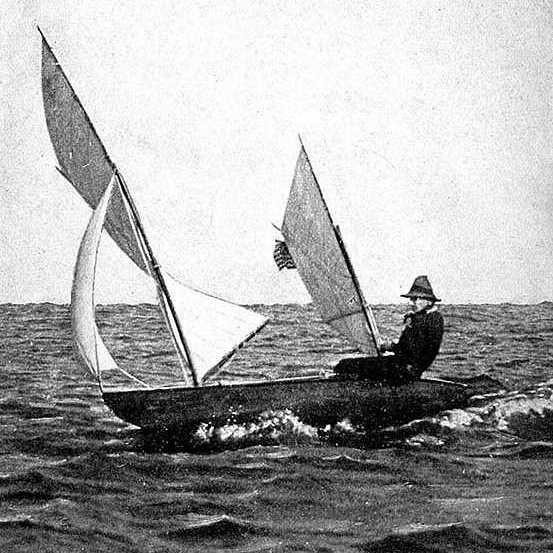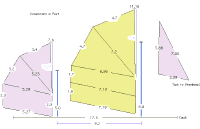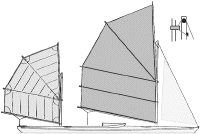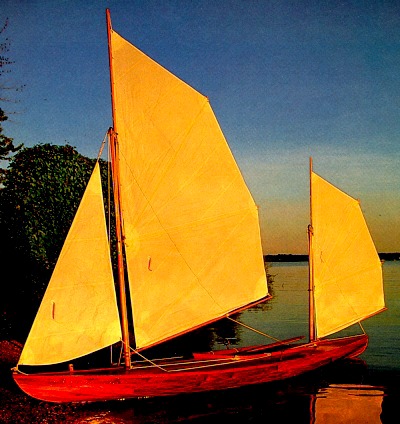Appendix: More About "Yakaboo" and the
Caribbean

Alone in the Caribbean went through at least 3 printings. I've seen copies dated 1917, 1940, and 1958. The 1917 edition has more photos than the later editions. All the photos are included here.
About Yakaboo's Builder
[Pages 128-129 ] in Sailing Craft, by Schoettle, ed.From the chapter "Canoeing Under Sail" by Maurice D. Wilt
Another very successful builder of splendid canoes was W. F. Stevens. Mr. Stevens was a waterman from his early youth. He built for himself a small sailboat when he was sixteen years old. Later he built racing shells, and rowed them too. While engaged in this business at Lowell, Mass., about 1890 he came under the notice of Paul Butler. From then on the names of Butler and Stevens became coupled among canoeists. Stevens built all the Butler designed and owned canoes, Wasp, Fly, Bee, Bug, etc., all wonders of design and workmanship and all successful racers.
In 1898 he located in Bath, Maine, where he built several of his most successful canoes. In 1906 he went to Marblehead, Mass., and became associated with W. Starling Burgess, well-known naval architect and sportsman. In 1910 he retired from business and went to live at Boothbay Harbor, Maine.
In 1913, however, he consented to build, from his own design, what was probably his most famous canoe, Mermaid, owned by Leo Friede and sailed by the latter in all his races. Damosel, another Stevens canoe, built about 1896, owned and sailed by James Newman, twice defeated Friede in important races on Charles River Basin, Boston, once in 1913 and again in 1919. Stevens also built Uncle Sam, in which H. Dudley Murphy unsuccessfully competed in England for the British Royal Canoe Club Challenge Cup in 1901, and he designed and built Yakaboo, a cruising canoe, in which Frederick A. Fenger cruised 800 miles in the Caribbean Sea from Grenada to the Virgin Islands, in 1907. Yakaboo was 17 feet long, 39 inches beam, and weighed 147 pounds. She had no rudder, being steered entirely by trimming the sheets, and by shifting the centreboard forward or aft as necessary. Her rig was a small jib and two hoisting batswing sails, that could also be reefed.
The last canoe built by Stevens was Doris III, built in 1918 for Mr. Yngve Froling of Gothenburg, Sweden. Doris III is 17 feet long and 40 inches beam, an able cruising canoe. Stevens died at his farm at Boothbay Harbor in 1922 or 1923. A splendid type of down east Yankee waterman.
Yakaboo's Rig
 |
Approximate dimensions. You have to love these batwing sails. |
 |
Sail plan, after John Leather in |
The Bruce Mines Museum
Open seasonally: the original Yakaboo is there. They still haven't gotten the word about Yakaboo's actual builder.
Mystic Seaport Museum
In the manuscript collections at the Blunt Library you can see assorted documents from Fenger's trip, the manuscript version of Yakaboo's log, and a typescript of the logbook. There is much other Fenger material but it seems to be all related to his later experiments in hull shape and sail rig. Nevertheless it's interesting to read over the logbook.
Joe Youcha's Replica and Further Reading
 |
Joe's replica at sunset. Joe is associated with theAlexandria Seaport Foundation. A Bequia whaleboat is under restoration at ASF, too. Photo: Chris Kulczycki. |
WoodenBoat #82, page 5: (letter about Yakaboo by John Martsolf).Sail and Oar by John Leather: one chapter discusses rudderless boats including Yakaboo.
Items I have not seen:
Yachting Monthly (UK) - July 1921.Yachting (USA) - July 1914 and July 1919.
Nor the original Outing series.
West Indian Beach Punt
From Élisée Reclus, The Earth and its Inhabitants, North America / edited by A.H. Keane. New York : D. Appleton, 1890-1893. A drawing of the same type punt appears in American Small Sailing Craft by Chapelle. Fenger does not mention this type of boat, but it's unusual and apparently not well documented. The original volumes in French date from 1880-85 or so.(761x537 pixels)
Map
From Down the Islands by Wm. A. Paton, an account of a trip through the Caribbean in a steamer in the 1880s. Not very interesting once you've read Fenger but a few nice illustrations. Princeton University holds a collection of Paton's artwork and photos.(823x1311 pixels)
Map
From Reclus, above. See also Fragment of a Voyage to Louisiana, where Reclus writes of sailing through the Caribbean in about 1852.(1041x834 pixels)
More
Caribbean Compass, December 1999
- Writing on the Sea:
- An Historical Overview of Yachting in the
- Lesser Antilles in the 20th Century,
- as Revealed in Bibliographical Highlights
- by Richard Dey

